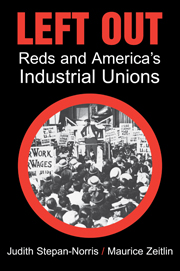Book contents
- Frontmatter
- Contents
- List of Figures and Tables
- Prefatory Note
- Acknowledgments
- Abbreviations
- 1 The Congress of Industrial Organizations: Left, Right, and Center
- 2 “Who Gets the Bird?”
- 3 Insurgency, Radicalism, and Democracy
- 4 Lived Democracy: UAW Ford Local 600
- 5 “Red Company Unions”?
- 6 Rank-and-File Democracy and the “Class Struggle in Production”
- 7 “Pin Money” and “Pink Slips”
- 8 The “Big 3” and Interracial Solidarity
- 9 The Red and the Black
- 10 Conclusion: An American Tragedy
- 11 Epilogue: The “Third Labor Federation” That Never Was
- References
- Author Index
- Subject Index
8 - The “Big 3” and Interracial Solidarity
Published online by Cambridge University Press: 28 July 2009
- Frontmatter
- Contents
- List of Figures and Tables
- Prefatory Note
- Acknowledgments
- Abbreviations
- 1 The Congress of Industrial Organizations: Left, Right, and Center
- 2 “Who Gets the Bird?”
- 3 Insurgency, Radicalism, and Democracy
- 4 Lived Democracy: UAW Ford Local 600
- 5 “Red Company Unions”?
- 6 Rank-and-File Democracy and the “Class Struggle in Production”
- 7 “Pin Money” and “Pink Slips”
- 8 The “Big 3” and Interracial Solidarity
- 9 The Red and the Black
- 10 Conclusion: An American Tragedy
- 11 Epilogue: The “Third Labor Federation” That Never Was
- References
- Author Index
- Subject Index
Summary
Blacks don't have the “speed and rhythm” for factory work, declared the head of the Michigan Manufacturers' Association on the eve of World War II, and he assured government investigators that “most Michigan employers have the same belief.” This was certainly the belief and the practice among auto employers (with the eccentric exception of Henry Ford). They simply refused to hire blacks, except, occasionally, as janitors. Two years into the war, with black employment increasing in many automotive plants – as a combined result of the “labor shortage” and the UAW's push, in cooperation with the FEPC, to open jobs for blacks – auto employers were still complaining that blacks “leave the job easily and are absent a lot.” In “automobile equipment,” black employment was 3.6 percent in 1940 (overwhelmingly at Ford) and rose to a high of 15 percent in 1945.
“Employers in electrical manufacturing,” as Ruth Milkman points out, “were even more hesitant to hire blacks” than in the auto industry. In 1940, 0.5 percent of the workers in “electrical machinery” were black; a year after Pearl Harbor, the figure was only 1.3 percent; and at the wartime employment peak, it was only 2.9 percent.
Black employment was so low in electrical manufacturing because employers relied on reserves of white women workers to meet their requirements. Robert C. Weaver, head of the Negro Employment Office of the War Production Board, observed in 1946 that “those industries which delayed longest the employment of Negroes … were usually light and clean manufacturing.
- Type
- Chapter
- Information
- Left OutReds and America's Industrial Unions, pp. 212 - 231Publisher: Cambridge University PressPrint publication year: 2002



